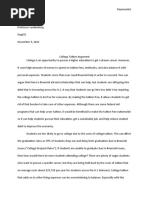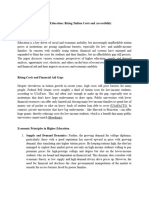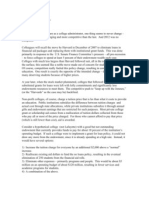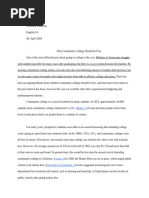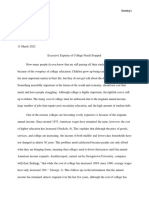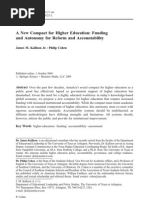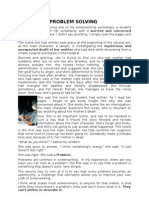0 ratings0% found this document useful (0 votes)
48 viewsFor Decades Free College 2014
For Decades Free College 2014
Uploaded by
notevaleThe document discusses proposals to make college more affordable and potentially free in the United States, as it is in some other countries. It outlines a proposal from the think tank Demos that would allow students to graduate debt-free by working a limited number of hours each week and receiving grants based on income to cover tuition and living expenses. The total estimated cost to implement this plan nationwide would be between $9-30 billion annually. Supporters argue this could make college as affordable as it was 30 years ago and boost the economy, while critics note it may require tax increases or cuts to other programs. [/SUMMARY]
Copyright:
© All Rights Reserved
Available Formats
Download as DOCX, PDF, TXT or read online from Scribd
For Decades Free College 2014
For Decades Free College 2014
Uploaded by
notevale0 ratings0% found this document useful (0 votes)
48 views3 pagesThe document discusses proposals to make college more affordable and potentially free in the United States, as it is in some other countries. It outlines a proposal from the think tank Demos that would allow students to graduate debt-free by working a limited number of hours each week and receiving grants based on income to cover tuition and living expenses. The total estimated cost to implement this plan nationwide would be between $9-30 billion annually. Supporters argue this could make college as affordable as it was 30 years ago and boost the economy, while critics note it may require tax increases or cuts to other programs. [/SUMMARY]
Original Description:
Article
Copyright
© © All Rights Reserved
Available Formats
DOCX, PDF, TXT or read online from Scribd
Share this document
Did you find this document useful?
Is this content inappropriate?
The document discusses proposals to make college more affordable and potentially free in the United States, as it is in some other countries. It outlines a proposal from the think tank Demos that would allow students to graduate debt-free by working a limited number of hours each week and receiving grants based on income to cover tuition and living expenses. The total estimated cost to implement this plan nationwide would be between $9-30 billion annually. Supporters argue this could make college as affordable as it was 30 years ago and boost the economy, while critics note it may require tax increases or cuts to other programs. [/SUMMARY]
Copyright:
© All Rights Reserved
Available Formats
Download as DOCX, PDF, TXT or read online from Scribd
Download as docx, pdf, or txt
0 ratings0% found this document useful (0 votes)
48 views3 pagesFor Decades Free College 2014
For Decades Free College 2014
Uploaded by
notevaleThe document discusses proposals to make college more affordable and potentially free in the United States, as it is in some other countries. It outlines a proposal from the think tank Demos that would allow students to graduate debt-free by working a limited number of hours each week and receiving grants based on income to cover tuition and living expenses. The total estimated cost to implement this plan nationwide would be between $9-30 billion annually. Supporters argue this could make college as affordable as it was 30 years ago and boost the economy, while critics note it may require tax increases or cuts to other programs. [/SUMMARY]
Copyright:
© All Rights Reserved
Available Formats
Download as DOCX, PDF, TXT or read online from Scribd
Download as docx, pdf, or txt
You are on page 1of 3
For decades, free high-school education helped strengthen the middle class and generate
prosperity. So isnt it time to extend the same thinking to college?
The idea might seem impractical, since college costs more than high school and higher
education isnt for everybody in the first place. Yet its also obvious that a high school
education alone isnt nearly as valuable as it used to be, which is why some researchers
and policymakers are now studying ways to make college as accessible as high school for
those who want it. College is free in Scandinavian countries and highly subsidized in much
of Europe, including Belgium, France, Italy and Spain. In Germany, an eight-year test of
new university fees ended recently with the last state abolishing them, making college free
throughout the country, as it was prior to 2006.
Attending a U.S. public university costs an average of $16,000 per year, and a new
proposal from Demos, a left-leaning think tank, outlines a way for students to graduate debt-
free in four years while working a limited number of hours. The poorest students would
receive grants that cover 75% of tuition and living expenses, with subsidized loans and
work-study jobs covering the rest. Grants would phase out for wealthier students, yet the
plan would still help reduce or eliminatestudent-debt burdens that for some graduates are
becoming a ruinous liability.
There have long been subsidized funding options such as Pell grants and scholarships, plus
all states cover at least a portion of the cost of state universities. But subsidized funding has
fallen far behind the rising cost of college, especially with budget shortfalls in many states
that have led to cuts in university funding and spikes in tuition. State and local college
funding per student, adjusted for inflation, has fallen by 23% during the last five years,
according to the State Higher Education Executive Officers Association. During the same
time, tuition per student has risen by 25%.
To make up the difference, students have been taking out record levels of loans, with the
total amount of student debt now topping $1 trillion. The average amount of debt per
borrower is approaching $30,000, and nearly one-third of borrowers dont even finish
college, leaving them saddled with the cost of a degree but not the benefit. While the value
of a college degree has become more important, weve erected more financial barriers to a
college education, says Mark Huelsman, who authored the Demos study.
The goal of the Demos proposal is to allow any student to pay for college by working a
minimum-wage job during the summer and 10 hours or so per week during the school
yearand graduate with little or no debt. That would make college roughly as affordable
today as it was 30 years ago.
To accomplish that, Demos would set up a federal-state partnership in which states get
federal grants based on how much of total education costs they cover for low- and middle-
income students; the higher the portion, the larger the federal grant. The zero-debt plan
would only involve public universities, because they're the ones meant to bring higher
education to the masses. Grants would cover 40% to 75% of college costs, depending on
income, but states could set up the program in other ways, as long as the goal was a zero-
debt degree. Wealthier families wouldn't qualifyDemos sets the threshold at $100,000 in
family income--though such students could still apply for loans and any other funding
available.
Demos estimates the total cost for its zero-debt degree, if implemented in every state,
would range from $9 billion to $30 billion. Some states might have to spend more on higher
ed, but others would qualify for federal grants based on current spending levels. In a perfect
world, with enlightened leaders, it might be possible to reorganize more than $100 billion in
federal education spending each year to fund such a program, without harming other
priorities. But that would probably benefit some institutions at the expense of others,
assuring a huge fight over any such education reform.
Congress is in no mood to raise taxes to pay for much of anything, yet some economists
argue that even with higher taxes, a well-administered boost in higher-ed spending would
pay for itself through a more productive workforce, greater economic output and higher tax
revenue.
Sen. Tom Harkin (D-Iowa) has proposed legislation similar to the Demos proposal, and
other members of Congress (mostly Democrats) support new programs to make college
more affordable. Sen. Elizabeth Warren (D-Mass.) is on a related crusade to make student
borrowing less burdensome. Nobody awaits salvation from Washington anymore, yet the
soaring cost of college is a top pocketbook issue for Main Street voters who send politicians
to Washington. If Germany can make college free, the United States can at least make it
cheaper.
Should a college education be free? If so, who should fund it? Join Rick Newman and
Demos's Mark Heulsman live on Facebook at 1 p.m. ET on Wednesday to talk about
free college in other countries, the rising cost of a U.S. education and possible
solutions. The chat will take place at www.facebook.com/yahoofinance.
Rick Newmans latest book is Rebounders: How Winners Pivot From Setback To Success.
Follow him on Twitter: @rickjnewman.
You might also like
- Cartier VuittonDocument17 pagesCartier VuittonhissariapallaviNo ratings yet
- BooksDocument1 pageBooksnotevaleNo ratings yet
- Position PaperDocument8 pagesPosition Paperapi-673819921No ratings yet
- Owen Mockabee - Literature ReviewDocument7 pagesOwen Mockabee - Literature Reviewapi-609373492No ratings yet
- Position Argument or ProposalDocument5 pagesPosition Argument or Proposalapi-253026182No ratings yet
- Free EducationDocument11 pagesFree EducationJoanMagnoMariblancaNo ratings yet
- Error: Reference Source Not FoundDocument11 pagesError: Reference Source Not FoundAnaValenzuelaNo ratings yet
- Fighting Back Against Rising Tuition 1Document7 pagesFighting Back Against Rising Tuition 1api-345124344No ratings yet
- Doyle, W. R. (2020) - Throwing Out The "Recession Playbook" For Higher EducationDocument10 pagesDoyle, W. R. (2020) - Throwing Out The "Recession Playbook" For Higher Educationreyna.xo21No ratings yet
- Is College Education Worth The CostDocument6 pagesIs College Education Worth The Costeson8No ratings yet
- Description: Tags: GarlandDocument4 pagesDescription: Tags: Garlandanon-8324No ratings yet
- University FundingDocument16 pagesUniversity Fundingapi-450356724No ratings yet
- CollegeDocument3 pagesCollegeapi-286125690No ratings yet
- Literature Review - Jessica Li 1201Document10 pagesLiterature Review - Jessica Li 1201api-583339690No ratings yet
- Companion PieceDocument1 pageCompanion Pieceapi-272743675No ratings yet
- Research Essay Jessica Li Eng1201Document12 pagesResearch Essay Jessica Li Eng1201api-583339690No ratings yet
- Online PieceDocument5 pagesOnline Pieceapi-272573140No ratings yet
- Deliberation Final Draft 1Document20 pagesDeliberation Final Draft 1api-548506463No ratings yet
- Obama Plan August 22 2013Document7 pagesObama Plan August 22 2013Barmak NassirianNo ratings yet
- Jan 11, 2002: Mark Yudof, "Is The Public Research University Dead?"Document4 pagesJan 11, 2002: Mark Yudof, "Is The Public Research University Dead?"Chris NewfieldNo ratings yet
- College Tuition ArgumentDocument10 pagesCollege Tuition Argumentapi-583497657No ratings yet
- Borrowing To Pay For College Took OffDocument7 pagesBorrowing To Pay For College Took Offarazw IssaNo ratings yet
- Positionproposal Final DraftDocument9 pagesPositionproposal Final Draftapi-246646503No ratings yet
- Paper 3 - EducationDocument3 pagesPaper 3 - Educationduryad32No ratings yet
- Guerreroeng102 ShortreportDocument7 pagesGuerreroeng102 Shortreportapi-357450912No ratings yet
- Cost of Competition12Document2 pagesCost of Competition12Robert MassaNo ratings yet
- Proposal Argument EssayDocument8 pagesProposal Argument Essayapi-644835690No ratings yet
- Description: Tags: FifieldDocument5 pagesDescription: Tags: Fifieldanon-130747No ratings yet
- Challenges of US HEDocument3 pagesChallenges of US HEКаріна ВолинецьNo ratings yet
- Making College More AffordableDocument6 pagesMaking College More AffordableCenter for American ProgressNo ratings yet
- Why Students Should Oppose Tuition Hikes and Ask For Free EducationDocument4 pagesWhy Students Should Oppose Tuition Hikes and Ask For Free EducationsylogluNo ratings yet
- Research-Com-EducaDocument10 pagesResearch-Com-EducacarloschanNo ratings yet
- Missed Opportunity For Tuition-Free College Education: Explaining Fee Increases at California State UniversityDocument6 pagesMissed Opportunity For Tuition-Free College Education: Explaining Fee Increases at California State Universityegv486No ratings yet
- Opinion Piece FinalDocument4 pagesOpinion Piece Finalapi-232063122No ratings yet
- College Essay Final DraftDocument4 pagesCollege Essay Final Draftapi-679915727No ratings yet
- Contra in StsDocument26 pagesContra in StskbassignmentNo ratings yet
- Should College Be FreeDocument7 pagesShould College Be Freeapi-530905331No ratings yet
- Why Community College Should Be FreeDocument4 pagesWhy Community College Should Be Freeamitchandrawanshi80661No ratings yet
- Issue BriefDocument10 pagesIssue Briefapi-455753141No ratings yet
- Thesis Statement On College DebtDocument5 pagesThesis Statement On College Debtaflodnyqkefbbm100% (2)
- ArgumentportfoliorewriteDocument7 pagesArgumentportfoliorewriteapi-242491136No ratings yet
- Burden of Higher Education in Recent TimeDocument3 pagesBurden of Higher Education in Recent Timeahmad hashamNo ratings yet
- 2003 Fall WeygandIntegratedApproachDocument1 page2003 Fall WeygandIntegratedApproachJohn O. HarneyNo ratings yet
- A Gener Ation H Obbled by The Soar Ing Cost of College: Loans Life InsuranceDocument11 pagesA Gener Ation H Obbled by The Soar Ing Cost of College: Loans Life InsuranceSimply Debt SolutionsNo ratings yet
- Making College More Affordable For New Yorkers Who Need The Most SupportDocument17 pagesMaking College More Affordable For New Yorkers Who Need The Most SupportCommunity Service Society of New YorkNo ratings yet
- Research EssayDocument12 pagesResearch Essayapi-548624559No ratings yet
- Synthesis Essay RDDocument5 pagesSynthesis Essay RDapi-575370382No ratings yet
- College For AllDocument6 pagesCollege For AllAnandKhalsaNo ratings yet
- Should College Education Be Free For AllDocument2 pagesShould College Education Be Free For Allquannase183082No ratings yet
- PF Con-Case Free Community CollegeDocument10 pagesPF Con-Case Free Community CollegeJugal AmodwalaNo ratings yet
- College AffordabilityDocument7 pagesCollege AffordabilityMatthew LeonardNo ratings yet
- Cost of University EducationDocument5 pagesCost of University Educationabdurahmonov.fayzullo2000No ratings yet
- HandorfDocument10 pagesHandorfapi-509677836No ratings yet
- Should College Be Free 1Document6 pagesShould College Be Free 1api-331450135No ratings yet
- CUCFA To Yudof Tuition HikeDocument4 pagesCUCFA To Yudof Tuition HikeChris NewfieldNo ratings yet
- Higher EducationDocument13 pagesHigher EducationYaw LamNo ratings yet
- CAP Debates OrganizationDocument13 pagesCAP Debates OrganizationAmina KingNo ratings yet
- Experiencing College Tuition As Students 1Document10 pagesExperiencing College Tuition As Students 1api-272573140No ratings yet
- Americans College PromiseDocument8 pagesAmericans College Promiseapi-430738231No ratings yet
- Top 10 Reasons For MA To Invest in Public Higher EDDocument11 pagesTop 10 Reasons For MA To Invest in Public Higher EDMatt VachonNo ratings yet
- Academic Paper - Financing Institutions in The Free College DebateDocument18 pagesAcademic Paper - Financing Institutions in The Free College Debategain maxNo ratings yet
- Indicators For SustainabilityDocument1 pageIndicators For SustainabilitynotevaleNo ratings yet
- MACROECONOMISDocument1 pageMACROECONOMISnotevaleNo ratings yet
- Reinforced Concrete Information-1 PDFDocument5 pagesReinforced Concrete Information-1 PDFnotevaleNo ratings yet
- Architectural Terms "Spandrel". (More Than Just Spandrel Glass!)Document5 pagesArchitectural Terms "Spandrel". (More Than Just Spandrel Glass!)notevaleNo ratings yet
- Calculating The Costs of Building An ADU 2019Document6 pagesCalculating The Costs of Building An ADU 2019notevaleNo ratings yet
- Sydney 2030 VisionDocument41 pagesSydney 2030 VisionnotevaleNo ratings yet
- Most Important Software That Every Civil Engineers Should KnowDocument1 pageMost Important Software That Every Civil Engineers Should KnownotevaleNo ratings yet
- WORD - Drag and Drop Single ImageDocument2 pagesWORD - Drag and Drop Single ImagenotevaleNo ratings yet
- MICROSOFT WORD - Drag and Drop Single Image Into Your Microsoft Word DocumentDocument2 pagesMICROSOFT WORD - Drag and Drop Single Image Into Your Microsoft Word DocumentnotevaleNo ratings yet
- ACI Quiz: Section 4Document1 pageACI Quiz: Section 4notevaleNo ratings yet
- Aashto: (1 Bookmark)Document10 pagesAashto: (1 Bookmark)notevaleNo ratings yet
- Calculating The Costs of Building An ADU 2019Document6 pagesCalculating The Costs of Building An ADU 2019notevaleNo ratings yet
- Calculate The Slope of The Relationship Between Dark Shadows and Think Like A ManDocument1 pageCalculate The Slope of The Relationship Between Dark Shadows and Think Like A MannotevaleNo ratings yet
- Calculate The Slope of The Relationship Between Dark Shadows and Think Like A ManDocument1 pageCalculate The Slope of The Relationship Between Dark Shadows and Think Like A MannotevaleNo ratings yet
- ECONOMICSDocument1 pageECONOMICSnotevaleNo ratings yet
- Masonry Assignment & Quiz #01Document1 pageMasonry Assignment & Quiz #01notevaleNo ratings yet
- Econ 1101Document1 pageEcon 1101notevaleNo ratings yet
- SandyDocument1 pageSandynotevaleNo ratings yet
- Construction Estimating PROJECT 02Document5 pagesConstruction Estimating PROJECT 02notevale100% (3)
- Cambridge Ordinary Level: Cambridge Assessment International EducationDocument4 pagesCambridge Ordinary Level: Cambridge Assessment International EducationIrzaNo ratings yet
- EN ReportDocument24 pagesEN ReportTâm TrầnNo ratings yet
- Krishna Kanta Handiqui State Open UniversityDocument39 pagesKrishna Kanta Handiqui State Open UniversityMukesh BishtNo ratings yet
- Inglés IV, Primera Edición, Yaneth Ocando Pereira - 3 - Unidad IIIDocument14 pagesInglés IV, Primera Edición, Yaneth Ocando Pereira - 3 - Unidad IIIrodmanjoseliragonzalezNo ratings yet
- Biology Class: 11 Unit: 1Document8 pagesBiology Class: 11 Unit: 1samiNo ratings yet
- สำเนา Price Quotation Template Excel Free DownloadDocument5 pagesสำเนา Price Quotation Template Excel Free DownloadenteNo ratings yet
- 1Document1 page1oziNo ratings yet
- Nat Reviewer UcspDocument7 pagesNat Reviewer UcspLeven Mart Lacuna100% (1)
- Ross12e Chapter21 TBDocument11 pagesRoss12e Chapter21 TBhi babyNo ratings yet
- Labour Colony Inspection Report - August 2023Document11 pagesLabour Colony Inspection Report - August 2023shamshad ahamedNo ratings yet
- The Sale of Goods Act 1930 (Sim)Document54 pagesThe Sale of Goods Act 1930 (Sim)Jithin SavioNo ratings yet
- What Is Brent Staples Thesis in Just Walk On byDocument4 pagesWhat Is Brent Staples Thesis in Just Walk On byygsyoeikd100% (2)
- Ingles IDocument35 pagesIngles ILizeth DiazNo ratings yet
- Born Again in Brazil The Pentecostal BooDocument3 pagesBorn Again in Brazil The Pentecostal Boomartin11750No ratings yet
- Bulletin June 13-2015Document2 pagesBulletin June 13-2015api-242081048No ratings yet
- Focus4 2E UoE Unit1 Unit4 Resource 57 58Document3 pagesFocus4 2E UoE Unit1 Unit4 Resource 57 58Алена Андреевна Пыко100% (1)
- Monteferro Product e ServiceDocument32 pagesMonteferro Product e ServiceMohamed ShafikNo ratings yet
- Accepted Manuscript - Eastern Poetry by Western PoetsDocument35 pagesAccepted Manuscript - Eastern Poetry by Western Poets高瑞梓No ratings yet
- The Art of Problem SolvingDocument3 pagesThe Art of Problem Solvingbhaskarchow50% (2)
- Cover LetterDocument2 pagesCover Letterapi-378236311100% (1)
- Unit 5: Differentiation and Integration of Exponential and Logarithmic FunctionsDocument25 pagesUnit 5: Differentiation and Integration of Exponential and Logarithmic FunctionsDane SinclairNo ratings yet
- M2L1 Phonology and MorphologyDocument18 pagesM2L1 Phonology and MorphologyJJ BuicoNo ratings yet
- Analysis For Glycerin Distillation Plant: 065 Oleocorp CPM Sket GMBHDocument2 pagesAnalysis For Glycerin Distillation Plant: 065 Oleocorp CPM Sket GMBHjalil ahmedNo ratings yet
- The NecklaceDocument3 pagesThe NecklaceBruce WayneNo ratings yet
- q1w9 - Grade 12 Media & InformationDocument4 pagesq1w9 - Grade 12 Media & InformationAnna Agravante-SulitNo ratings yet
- Cel de Al Treilea Ochi, Horus, Glanda Pineala Si Ovarul IncoltitDocument9 pagesCel de Al Treilea Ochi, Horus, Glanda Pineala Si Ovarul IncoltitluizetteNo ratings yet
- Lubrication System (Hilux/1Kd-Ftv, 2Kd-Ftv (Tasa Made For Argentina) )Document2 pagesLubrication System (Hilux/1Kd-Ftv, 2Kd-Ftv (Tasa Made For Argentina) )grivaskachiswe40No ratings yet
- The Persian EmpireDocument10 pagesThe Persian Empireapi-426413696No ratings yet
- Marketing PrinciplesDocument2 pagesMarketing Principleskeltoum mekidNo ratings yet




















